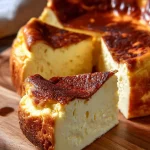Ingredients
Ingredients:
- 3½ cups cream cheese (room temperature)
- 1¼ cups granulated sugar
- ¼ teaspoon salt
- 5 large eggs
- 1 teaspoon vanilla bean paste
- 1¼ cups heavy cream
- 3 tablespoons all-purpose flour
The cream cheese must be at room temperature for smooth mixing. I usually take it out about 2 hours before baking. The vanilla bean paste adds those beautiful black specks and deeper flavor than regular vanilla extract, though you can substitute with extract if needed.
Instructions
1. Prepare Your Oven and Pan Preheat your oven to 410°F (210°C). This high temperature is crucial for creating that characteristic burnt top. Grease your 9-inch springform pan thoroughly with butter or cooking spray. Line it with parchment paper, allowing it to overhang the edges by about 2 inches. Don’t worry about making it neat – those wrinkled edges are part of the charm.
2. Mix the Cream Cheese and Sugar In a large mixing bowl, beat the room-temperature cream cheese and sugar together using an electric mixer on medium speed. Mix for 2-3 minutes until the mixture is completely smooth and fluffy. Make sure there are no lumps – this is crucial for a silky final texture.
3. Incorporate the Eggs Add the eggs one at a time, beating well after each addition. This gradual incorporation prevents the mixture from curdling. Scrape down the sides of the bowl frequently to ensure everything is well combined. The mixture should be smooth and pale yellow.
4. Add Cream and Flavorings Pour in the heavy cream, vanilla bean paste, and salt. Beat the mixture until it becomes silky smooth and well combined. The batter should be loose and pourable at this point. The cream adds richness and helps create that creamy interior texture.
5. Fold in the Flour Sift the flour directly into the mixture to prevent lumps. Mix just until the flour is incorporated – don’t overmix at this stage. The flour helps stabilize the cheesecake and gives it structure, but too much mixing can make it tough.
6. Bake the Cheesecake Pour the batter into your prepared pan and smooth the top gently. Bake for 50-60 minutes, or until the top is deeply golden brown and the center is still slightly jiggly when you gently shake the pan. The top should look almost burnt – that’s exactly what you want.
7. Cool and Chill Let the cheesecake cool completely at room temperature. This can take 2-3 hours. Once cooled, refrigerate for at least 4 hours, though overnight is better. This chilling time allows the texture to set properly and the flavors to develop.
8. Serve and Enjoy Carefully unmold the cheesecake and peel away the parchment paper. The rustic edges and burnt top are part of its appeal. Slice with a sharp knife, wiping it clean between cuts for neat slices.
Notes
- Use room temperature cream cheese to avoid lumps
- Don’t overmix once you add the flour – just combine until smooth
- The center should still jiggle slightly when done – it will set as it cools
- Let it cool completely before refrigerating for best texture
- Serve at room temperature for the creamiest texture
- Store covered in the refrigerator for up to 5 days
- Can be frozen for up to 3 months (thaw overnight in fridge)
- Tastes best after resting overnight in the fridge
- If the top isn’t burnt enough, broil for 1-2 minutes at the end
- Cracks are normal and add to the rustic charm
- If it’s too soft, it may need more baking time or longer chilling
- Prep Time: 15 minutes
- Cook Time: 50 minutes
- Category: Dessert
- Method: Baking
- Cuisine: Spanish
Nutrition
- Serving Size: 1 slice
- Calories: 400 kcal
- Sugar: 25 g
- Sodium: 150 mg
- Fat: 32 g
- Saturated Fat: 20 g
- Unsaturated Fat: 10 g
- Trans Fat: 0.5 g
- Carbohydrates: 20 g
- Fiber: 0 g
- Protein: 6 g
- Cholesterol: 130 mg
